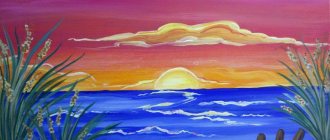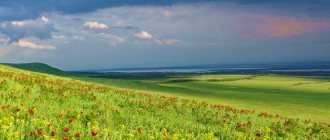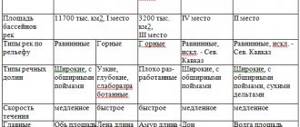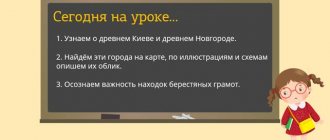The emergence of man and his settlement on the planet
One of the most difficult questions is the question of the place and time of the emergence of man on Earth.
Most scientists believe that Africa is the birthplace of man. This happened approximately 1 million years ago. No, no, modern man has been living on Earth not so long ago. A million years ago, the first intelligent beings appeared, the ancestors of modern humans. They walked on two legs and skillfully used their hands to make tools. Perhaps they had the rudiments of speech. But outwardly they were still very far from modern man (Fig. 75). However, their development did not stand still. These creatures improved, developed their thinking abilities, and carefully mastered the nature around them. And of course, they changed in appearance. Modern man, almost no different from you and me, appeared relatively recently, about 40 thousand years ago.
By this time, people no longer lived only in Africa. Long before the appearance of modern man, the settlement of primitive people around the planet began. Why would they leave their homeland? Was life really bad there? But the fact is that there were more and more people, they needed more food and more space. And since our primitive ancestor was a dexterous, quick-witted creature and able to adapt to completely new living conditions, he began to explore more and more new territories.
The routes of human settlement ran across continents, from continent to continent. Almost 30 thousand years ago, ancient tribes found themselves in North America, and after 10 thousand years South America was also developed (Fig. 76). At the same time as North America, people appeared in Australia. This is how it turned out that man settled throughout the planet. Only he failed to reach Antarctica. But even if he got there, it’s unlikely that he would like it there.
Human economic activity and its consequences
Man is not an ordinary inhabitant of our planet. This is the only creature on Earth that is endowed with intelligence. Man's transformation of nature for his own purposes is called economic activity. Along with the development of mankind, the nature of its economic activity also changed.
Primitive man hunted and collected edible plants, so he did not change nature that much. His relationship with nature was much the same as that of any large predator. Man took from nature only what she willingly gave him herself. Can this be considered an economic activity? Can. Only this was still the most primitive type of economy, which is called an appropriating economy .
But about 10 thousand years ago, human life began to change. Perhaps the climate of the planet has changed or people have become too numerous, but hunting has ceased to satisfy their needs for food. And man began to domesticate some animals and grow those plants that he had previously simply collected. This is how agriculture appears in people's lives. Agriculture has already given man not only what nature is ready to give on its own. No, with its help, man began to produce more food than wild nature could provide. Man has become less dependent on nature. This is how the transition from an appropriating to a producing economy (Fig. 77). The transition to a productive economy has led to an increased impact of economic activities on nature.
End >>>
Lesson summary: Human impact on nature
HUMAN IMPACT ON NATURE
The purpose of the lesson
: to form students’ idea of the environmental situation in the world, country, city in which we live
Tasks:
1. Lead students to the idea that the world is at the point of doom, illustrating this statement with specific examples.
2. Continue to develop students’ skills to think critically, solve problems in an innovative way, and argue their position.
3. To form an active environmental position of students on environmental protection.
Lesson type
: learning new material.
Forms of organizing student activities
: individual, frontal.
Lesson plan:
- Ecology
- "Second Nature"
- Natural resources
- Pollution of water, soil, atmosphere
Lesson equipment
:
- Textbook: Social Science, ed. L.N. Bogolyubova, L.F. Ivanova, 5th ed., Moscow, “Enlightenment”, 2020.
- Computer, projector.
During the classes:
- Organizational moment (children’s emotional mood).
– musical accompaniment: sounds of nature, birdsong, the sound of a stream...slides of a computer presentation depicting natural landscapes. (Slide 1-3)
Teacher:
Let's stop at the last landscape and discuss it. The discussion can be structured approximately according to this plan: what is the artist talking about in his painting? What picturesque features of the painting attracted you? What mood did contemplation of this painting evoke in you? What attitude towards nature did the artist want to convey? Have you ever personally seen such a landscape in life? What are your impressions? Would you like to visit there again? If so, why?
Students:
express their expected answers.
Teacher:
Now let's look at other pictures. What kind of relationship between man and nature have you seen? Have you seen such a “landscape”? (Slide 4-6)
Let's think about this topic today!!!!
Epigraph of the lesson.
Teacher: Read the epigraph to the lesson:
"If I pick a flower, if you pick a flower,
If we: both me and you - if we pick flowers,
There will be no nature left and no beauty!” (Slide 7)
Teacher:
What do you guys think, what will we talk about in today's lesson? What is the topic of our lesson today?
Students:
independently formulate the topic of the lesson - Human impact on nature. (Slide 
- Learning new material
Activation of mental activity.
Ecology
Teacher:
Think about it, what is the loudest word on Earth? Do you mean not by the strength of the sound of this word, but by the anxiety of its sound, causing a feeling of danger, fear?
Listen to the words of the famous writer Valentin Rasputin, who expressed his opinion on this issue:
“Surprisingly, it sounds the same in all languages of the world. And it expresses the same thing - an understanding of universal misfortune that has never before existed on such a scale... It is even louder than war and the elements” (Slide 9)
Teacher:
What do you think the poet was talking about?
Students:
express expected answers (
Ecology
)
Teacher:
What do you know about ecology, about the ecological crisis?
Students:
express their expected answers.
(Ecology is the science of the interaction of organisms, including humans, with the environment (scientific concept).
Ecology is the state of the environment. For example, good ecology, bad ecology (in a broad sense).
An ecological crisis is a difficult state of nature, the destruction of the environment. (Slide 10).
Teacher:
Guys, write down these concepts and their definitions in your notebook.
Setting a learning task.
Teacher:
Why do the writer’s words sound so alarming? Where did this trouble come from? And why did it become universal? (Slide 11).
Students:
express their expected answers
.
(Human economic activity throughout the globe. Man began to actively interfere with the life of nature, not always thinking about the consequences). Teacher:
Well done, these are our main questions that we have to answer, and to which we will return at the end of the lesson, and the content of today's lesson will help you supplement your answers.
"Second Nature"
Teacher:
So, let's continue our lesson. Read paragraph 15 “Second Nature” on your own, page 122 of the textbook and complete task No. 1 in the directions for today’s lesson (Appendix 1). Independent work of students with the text of the textbook § 15
Students:
complete the task independently.
Teacher:
So, let's check how you completed the task. (Oral survey on assignment questions).
Students:
express their expected answers.
( Question 1. What were the main occupations of primitive man? What is a productive economy? What has changed in people’s lives in connection with its appearance
?
Ancient people were engaged in gathering, hunting and fishing. The tools were the simplest: wooden clubs, sharpened sticks, hand axes made of stone. Caves were used as dwellings. In those days, people already used fire, but they did not yet know how to light a fire on their own, and maintaining a fire in the cave was an important responsibility of every member of the community.
A producing farm is a farm where the main source of subsistence is cultivated crops and domestic animals. In the transition from an appropriating economy to a producing economy, society moved from hunting and gathering to pastoralism and agriculture. This was a complex and lengthy process that began in the most ancient centers (centers) 12 - 10 thousand years ago, when various centers for the domestication of animals and plants arose. Only the combination of crop production with cattle breeding became a decisive moment in the development of the economy. Labor productivity increased and the possibility of accumulating surplus product emerged: for farmers - grain, for early livestock breeders - livestock. With the development of agriculture (especially irrigation) and mobile cattle breeding, social stratification and early class relations, in particular slaveholding and feudal relations, gradually emerged. Urban trading centers appeared, crafts separated from agriculture, exchange between different ethnic groups and historical and cultural regions increased, various economic and cultural types were formed both on the basis of manual labor in agriculture and on the basis of the use of draft power of livestock when cultivating fields, which was the next important stage in the economic and cultural development of mankind. (Slide 12)
Question 2. How do you understand the expression “second nature”?
(Slide 13).
Second nature is nothing more than nature in its symbolic meaning. This is a world produced by humanity previously in nature of non-existent things, processes, states. It is an addition to nature, which then becomes a habit.)
Natural resources
Teacher:
Well done.
You and I know that ecology is the science of the interaction of organisms, incl. person with the environment. A person, carried away by rapid economic activity, did not notice how he began to destroy and destroy nature: cutting down forests, extracting minerals from the depths of the earth, wasting fresh water, exterminating rare species of animals.
There is a great ecological rule - you cannot demand more from nature than it is capable of giving. (Slide 14)
This means that in order not to cause trouble, you need to study the laws of nature. For example, we must take into account that all natural resources are divided into two groups - exhaustible, i.e. those that in the future can be completely exhausted, and inexhaustible.
Guys, complete the following task - No. 2 in your waybill, working with the item “Invaluable gift or inexhaustible pantry?”, on page 123 of the textbook, fill out the diagram “Types of natural resources”
Students:
complete the task independently.
Teacher:
So, let's check how you completed the task. (Oral survey on assignment questions).
Students:
express their expected answers. Exhaustible: mineral wealth, flora and fauna, soil; Inexhaustible: water resources, climate resources, space resources). (Slide 15).
Pollution of water, soil, atmosphere
Teacher:
The great Russian scientist Vladimir Ivanovich Vernadsky at the end of the 19th century, observing the development of industrial society, thought about the powerful impact of man on the biosphere - the living shell of the Earth. The scientist realized for the first time that a gigantic process of changing nature was underway under the influence of the human mind. With his scientific discoveries, he made people think about the negative impact of their activities on the environment. (Slide 16).
In our time, pollution of the biosphere has become a terrible environmental disaster.
Guys, now, working in pairs (on desks), with the text of the textbook, tell us about the causes of pollution of individual parts of the biosphere and the dangerous consequences of this pollution for humanity according to the following plan:
1. Causes (sources) of pollution.
2. Consequences for humanity
Record your answer in your notebooks.
A)
air pollution c.
128-130 B)
water and soil pollution p.
130-131 (Slide 17) Students:
complete the task independently.
Teacher:
So, let's check how you completed the task.
Students: express their expected answers. (A ) air pollution -
Sources of pollution are factories and transport. As a result, atmospheric oxygen is burned, without which the existence of humans and other living beings is impossible, as well as smoke, which results in the formation of a toxic fog - smog; B) water and soil pollution - Sources of pollution are atmospheric pollution, industrial waste, especially chemical waste, and household waste.
As a result, there is a worldwide deterioration in water quality, a lack of fresh clean water, soil pollution with garbage, pesticides, and a reduction in soil area (over the last 100 years, 1/4 of the fertile land has been destroyed.) (Slide 8, 19) Teacher:
Well done. Guys, please tell me, what conclusion can be drawn from the information received?
Students:
express their expected answers (The greatest danger to the atmosphere is from industrial pollution, and from household waste to soil and water). (Slide 20).
- Summing up the lesson:
Teacher:
Well done. Guys, let us return to the words of the writer Valentin Rasputin, who believes that the loudest word, even louder than war and disaster, was the word ecology, and we will try once again to answer the questions posed at the beginning of the lesson:
Why do the writer’s words sound so alarming?
Where did this trouble come from?
And why did it become universal? (Slide 21)
Students:
express their expected answers.
( Modern people actively influence nature, not always thinking about the consequences. We see how the climate has changed on earth, how polluted the air is in large cities. Weather phenomena are becoming less predictable for us, we are deprived of a comfortable living environment. We get sick more often, which means we spend more money on medicines.
Environmental changes are global, they are happening all over the planet, and they need to be addressed by all of humanity.)
- Reflection. (Slide 22-26)
- What occupation of people in ancient times could be environmentally harmful?
1)hunting
2) picking mushrooms and berries
3) metal processing
4) gardening.
- One of the causes of modern environmental disasters is:
1)an increase in the number of animals on the planet
2) planting forests around cities
3) a large number of herbarium lovers
4) pollution of the waters of the World Ocean.
- Which of the following is true of “second nature”?
1) a river flowing near the house
2) forest outside the city
3)birds on the tree
4) car at the entrance.
- Exhaustible natural resources include:
1) wind
2) Sun
3) soil
4) ebbs and flows.
- Living shell of the Earth:
1) atmosphere
2) could
3) biosphere
4) lithosphere.
V. _ Homework:
1. Read § 15
2. Prepare a report on endangered species of plants and animals in the Krasnoyarsk Territory.
3. Prepare a report on extinct (over the last 10-15 years) species of plants and animals in the Krasnoyarsk Territory.
4. Ecological state in Achinsk. (Slide 27).





